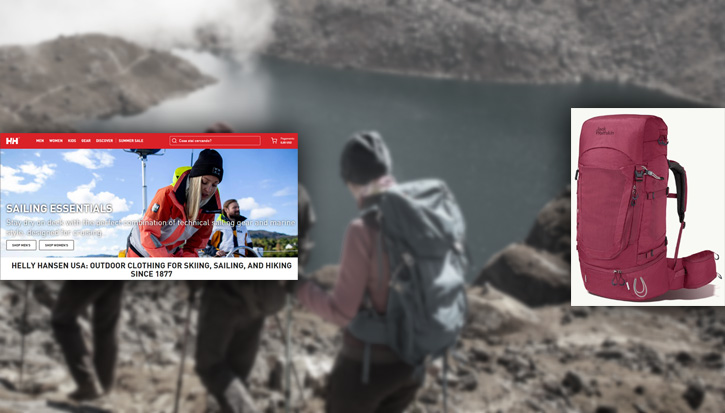
You probably already know that having reliable gear is essential, whether you’re hiking mountain trails or braving the elements on an outdoor adventure with friends.
And two brands that provide reliable outdoor gear, clothing, and equipment are Jack Wolfskin and Helly Hansen.
Both offer durable products for active outdoor lifestyles. But which is the better choice for you?
In today’s comparison, we’ll explore the main aspects and characteristics of each company to help you choose the brand that is best for you. Or at least help you have clearer thoughts for your next purchase.
Let’s get started right away!
Contents:
1. Jack Wolfskin Outdoor Gear
History of the Brand
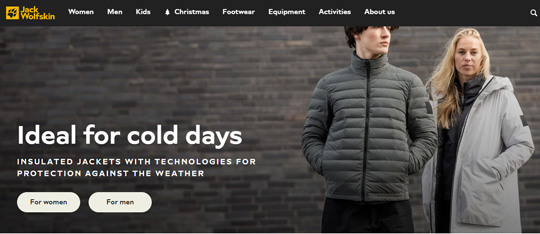
Jack Wolfskin’s official website
You have likely come across the name Jack Wolfskin, particularly if you live in Europe. This German brand was founded in 1981 in Frankfurt by Ulrich Dausien and has been based in Idstein, Germany since 1997.
Over the years, Jack Wolfskin has become one of the leading outdoor brands in Germany, offering a large collection of products. It has also gained significant popularity in other European countries.
Presently, the company provides a broad selection of gear for many outdoor activities, including clothing, shoes, sleeping bags, backpacks, tents, etc.
Jack Wolfskin has maintained a strong focus on sustainability, reducing its environmental footprint, and social accountability, aligning with the philosophy of numerous other outdoor apparel and equipment brands.
This dedication is evident in its product line, making it a commendable model of a good enterprise when it comes to protecting natural environments. The company’s style and performance appeal to both enthusiasts who want high-quality casual wear and those in search of excellent outdoor equipment.
Don’t miss:
9 German Jackets and Outdoor Clothing Brands that You’ll Love
Fjällräven vs Jack Wolfskin: Which Brand is Better?
Materials, Fabrics, and Production Process
Jack Wolfskin, a brand committed to environmental responsibility, incorporates recycled materials such as recycled polyester in its outdoor products to minimize its environmental impact as much as possible.
The brand also utilizes a range of natural and synthetic materials for insulation, such as natural RDS-certified Down, Microguard (synthetic), PrimaLoft (synthetic), and Fibercloud (synthetic).
As for fabric technologies, Jack Wolfskin uses Texapore, a breathable, windproof, and waterproof fabric that is also water-resistant and snow-resistant.
Texapore is used in coats and sports clothing and comes in various options and protection levels to cater to different outdoor activities.
The video will be loaded from YouTube.com, a third party. If you play it, you accept their terms of service, and their use of cookies.
Read also:
Jack Wolfskin vs Patagonia: Which is Better?
Jack Wolfskin vs The North Face Outdoor Gear: A Comparison
Where is Jack Wolfskin’s outdoor gear made?
Jack Wolfskin produces in both Europe and Asia. Their production facilities are situated across various Asian countries such as Vietnam, China, Bangladesh, and South Korea. In Europe, they are present in Germany, Slovenia, Turkey, and Italy. The raw materials are sourced from Europe, the USA, and Asia. (source)
Recommended Products
Jack Wolfskin Troposphere Men’s Insulated Jacket
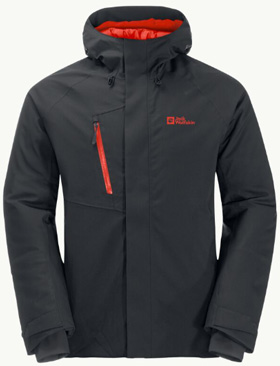
Image: jack-wolfskin.com
Check it out at Jack-Wolfskin.com
The Jack Wolfskin Troposphere represents a timeless and simple yet very practical and flexible insulated hardshell jacket. It incorporates a Texapore Pro fabric renowned for its good windproof, waterproof, and breathable properties, safeguarding against the elements while facilitating the dissipation of excess heat and moisture, enhancing freedom of movement.
The jacket is insulated with PrimaLoft Black Rise fill, a moisture-resistant recycled synthetic fiber insulation that provides warmth in cold weather. It boasts three outer pockets and one internal pocket for securely stowing small items.
The recycled materials being used, reflect Jack Wolfskin’s focus on eco-sustainability in its production. Its advanced materials and insulated build, make the Troposphere jacket great for dynamic outdoor use in chilly and wet conditions.
Jack Wolfskin Highland Trail 50+5 Women’s Trekking Pack
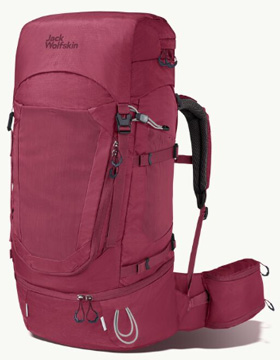
Image: jack-wolfskin.com
Check it out at Jack-Wolfskin.com
The Highland Trail 50+5 Backpack is specifically made for women, providing a comfortable fit and women-specific features. Boasting a 50+5-liter capacity, it offers ample storage for extended journeys.
Equipped with a height-adjustable X-Transition back system, it ensures comfort, effective ventilation, and optimized load distribution, facilitating the carriage of heavy loads. The dual-access main compartment permits flexible packing and gear retrieval from both the top and front zipper.
Also, the zipper on the lid pocket enables swift access to items. The elasticated mesh front pocket serves as a convenient storage space for your hiking jacket. The waist belt incorporates a pocket for a water bottle, and the backpack is designed to accommodate a hydration bladder.
Made from recycled materials, this bluesign-certified, PFC-free pack is committed to sustainability.
Prices
When it comes to Jack Wolfskin gear, there is a wide range of affordable options available. This brand offers a variety of items suitable for all those looking to expand their outdoor gear collection.
However, it’s worth noting that Jack Wolfskin also offers expensive items, such as jackets ranging from $60 to $800, backpacks from $50 to $400, and shoes from $60 to $230.
Are Jack Wolfskin products worth the price?
If you ask us, Jack Wolfskin’s gear justifies its price. If you want top-notch equipment with a fair price-to-quality ratio, you can rely on them. They are famous for employing quality materials and the latest technology.
Must read: 9 High-End, Expensive Hiking Brands for Clothing and Footwear
2. Helly Hansen Outdoor Gear
History of the Brand
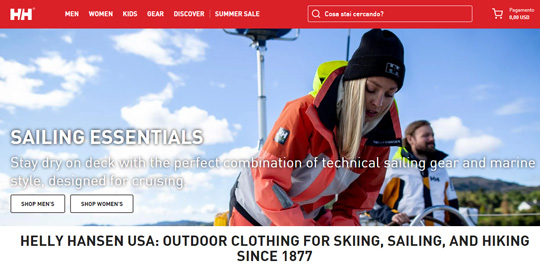
Helly Hansen’s official website
Helly Hansen is a well-known Norwegian brand founded in 1877 by sea captain Helly Juell Hansen, specializing in water and mountain gear.
Originally created to protect sailors from extreme weather, the brand has evolved over 140 years to encompass a wider range of activities, including skiing.
It is highly regarded in the sailing industry and popular among professionals and enthusiasts alike. In addition, Helly Hansen prioritizes mountain gear, providing apparel and equipment for various mountain activities such as mountaineering, trekking, skiing, and backpacking.
Don’t miss:
9 Brands like Helly Hansen: Our Top Alternatives
10 Norwegian Jackets and Clothing Brands that You’ll Love
Materials, Fabrics, and Production Process
Helly Hansen incorporates water-resistant treatments into its clothing to enhance the safety of sailors and fishermen facing harsh ocean conditions.
Their main fabric technology, Helly Tech, is both breathable and highly waterproof, similar to Gore-Tex.
The brand also offers popular fabrics such as Nylon, Polyester, Wool, and Fleece, many of which are recycled, and RDS-certified Down.
Recognizing the importance of environmental conservation, Helly Hansen prioritizes ethical values and environmental protection in its manufacturing systems. For more information about the company’s sustainability programs, you can find details on the official website.
The video will be loaded from YouTube.com, a third party. If you play it, you accept their terms of service, and their use of cookies.
Read also:
3 Best Norwegian Backpack Brands: Our Top Picks
Helly Hansen vs Patagonia: Which Brand is Better?
Where is Helly Hansen’s outdoor gear made?
Helly Hansen produces its outdoor gear and apparel mainly in Asia, in countries like China, Vietnam, Cambodia, and Bangladesh. The company gets its fabrics and raw materials from manufacturing facilities situated in Asia and Europe (source).
Recommended Products
Helly Hansen Verglas Infinity Men’s Shell Jacket
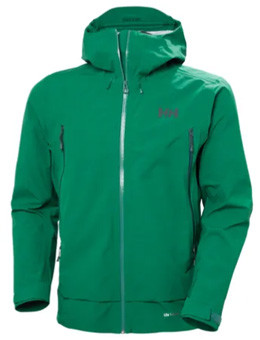
Image: hellyhansen.com
Check it out at HellyHansen.com
The Helly Hansen Verglas Infinity Men’s Jacket is specifically developed with the input of professionals who face unpredictable weather conditions during extended periods in the mountains. It is well-suited for backcountry skiing, trekking, and mountaineering.
The jacket incorporates the brand’s highly waterproof/breathable LIFA INFINITY™ technology, ensuring reliable protection without the use of chemicals. Additionally, it is constructed with a recycled face fabric and a PFC-free durable water repellent treatment, aligning with eco-friendly practices.
This hard shell provides maximum protection and is designed to be compatible with backpacks, helmets, and harnesses. Notable features include pit zips for ventilation, a RECCO® transponder, and a waist drawcord for added warmth.
Helly Hansen Transistor Backpack Recco®
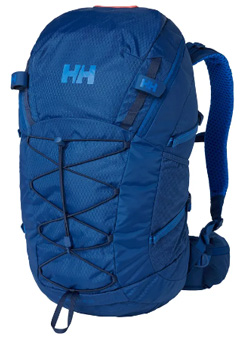
Image: hellyhansen.com
Check it out at HellyHansen.com
The 30L Transistor backpack is a top pick for outdoor pursuits, combining versatility and performance in a compact design.
It boasts numerous features including full hydration compatibility, multiple pockets, 3D air-mesh ventilation, and a RECCO® reflector, enhancing safety during outdoor adventures.
Prices
Helly Hansen offers a range of products with varying prices in the mid-to-high range. Their jackets are priced between $75 and $2000, while their backpacks start at $50 and can exceed $250. The pricier coats are made for expeditions in severe conditions and feature the most advanced technologies of the brand.
Are Helly Hansen products worth the price?
It can be difficult to find a more affordable option with comparable quality and longevity when searching for high-performance outdoor equipment, despite the seemingly expensive nature of this brand. So, we are of the opinion that Helly Hansen is worth the investment if you want high-performing gear.
Learn more: Why is Helly Hansen so Expensive and Popular: Is It Worth It?
3. Which is Better? Jack Wolfskin or Helly Hansen?
Both are well-established brands and both are great for outdoor, technical apparel and gear. Here’s what to keep in mind for your next purchase:
Origins: Jack Wolfskin was founded in 1981 in Germany, while Helly Hansen was founded much earlier in 1877 in Norway.
Sustainability is an important focus for both brands. They use recycled and eco-friendly materials in their products and aim to minimize environmental impact.
Quality seems to be comparable between the two. They use advanced technical fabrics and durable construction and design their products for optimal performance. Both have their own waterproof/breathable fabric technologies: Helly Hansen with Helly Tech and Jack Wolfskin with Texapore.
Prices: both offer a range of mid-to-high-end options. Helly Hansen is more expensive though, with its expedition jackets reaching $2000.
Products: Jack Wolfskin has a broader product selection covering multiple outdoor activities. It also offers tents and sleeping bags. Helly Hansen focuses more on water activities, sailing gear, and technical mountain apparel. Both have lifestyle collections for everyday use.
In the end, the key differences are Jack Wolfskin’s wider range of products vs Helly Hansen’s specialization in water/mountain activities.
So, for general outdoor use, Jack Wolfskin offers more versatility also due to its lower prices. But for technical water and mountain activities, we’d choose Helly Hansen given its expertise developed over 140+ years.
What do you think? Share your experience in the comments below.
Read next:
11 European Brands for Outdoor Enthusiasts: Our Top Picks
Columbia vs Helly Hansen: Which Brand is Better?
